Oil seed rape (OSR) is by far the most widely grown UK crop whose seeds have been treated with neonicotinoids. The flowers of OSR are visited by bees, and are now widely blamed for killing these bees.
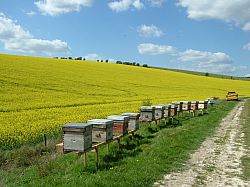 LASI's honey bee hives next to an OSR field
LASI's honey bee hives next to an OSR field
The issue of neonics and bees is controversial, especially where field-realistic doses are concerned, with some studies showing that bumble bee colonies can be harmed or that individual honey bees can become disoriented. However, others suggest no correlation between honey bee populations and the use of neonics. The number of honey bee hives has been declining some years before the introduction of neonics approximately 20 years ago. Better data are needed on the amounts of insecticide present in the nectar and pollen in OSR, how much bees forage on this crop, and if and how this pesticide affects colony performance.
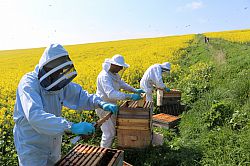 LASI researchers inspecting honey bee hives
LASI researchers inspecting honey bee hives
In one Sussex Plan project, using dance decoding and pollen analysis, researchers at LASI found that when bee hives were more than 1.5 to 2 kilometres from the nearest OSR fields they did not forage on OSR. In hives located less than 1 kilometres from the nearest field, dance decoding showed foraging in OSR fields of around 23% (i.e 77% of forager bees went elsewhere) and the pollen analysis showed that only 13% was from OSR. This shows that lab studies which assume that all the bee foraging was on OSR just is not realistic. Bees have a choice. Clearly, expecting a blooming OSR field to attract bees for miles around is not the case. OSR flowers in the spring when many other plants are in bloom.
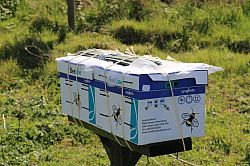 Bumble bee colony
Bumble bee colony
LASI are currently carrying out a large project using 72 honey bee hives, half placed next to fields of OSR, (to maximize their exposure), the other half placed in nearby apiaries 1.2km + from the nearest OSR fields. Each hive has been fitted with a pollen trap to monitor pollen collection. Colony performance will also be recorded (amount of brood, weight gain, queen and colony survival). The aim of this project is to detect any harm from the OSR fields. We are also monitoring the performance of 72 bumble bee colonies in the same apiaries. Results to follow.
This project is being led by PhD student Nick Balfour with the help of LASI’s research facilities manager, Luciano Scandian, PhD student Hasan Altoufailia, and Heloise Blanchard, a visiting French student completing her Masters degree.
Publications:
Carreck, N., Ratnieks, F. L. W. 2013. Will neonicotinoid moratorium save the bees? Research Fortnight http://www.researchresearch.com/index.php?option=com_news&template=rr_2col&view=article&articleId=1336394
Ratnieks, F. L. W., Carreck, N. L. 2010. Clarity on honey bee collapse? Science 327: 152-153.
Carreck, N. L., Ratnieks, F. L. W. 2014. The dose makes the poison: have “field realistic” rates of exposure of bees to neonicotinoid insecticides been overestimated in laboratory studies? Journal of Apicultural Research 53: 607-614.
Garbuzov, M., Schürch, R., Couvillon, M. J. C., Ratnieks, F.L.W. Honey bee dance decoding shows limited foraging on oilseed rape, a potential source of neonicotinoid contamination. Agriculture, Ecosystems & Environment (accepted)
Submitted:
Balfour, Carreck, Ratnieks. Effect of plant size on neonic contamination in corn and oil seed rape plant tissues following seed treatment with neonics.
Awaiting Submission:
Schürch, R., Ratnieks, F. L. W. Determining the foraging potential of oilseed rape to honey bees using aerial surveys and geographical modelling.
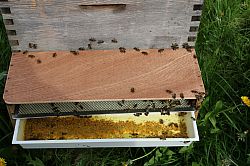 Pollen trap on a honey bee hive
Pollen trap on a honey bee hive
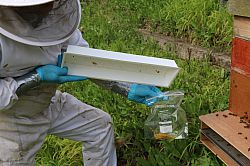 Collecting the pollen from the hive to analyse for neonicotinoids
Collecting the pollen from the hive to analyse for neonicotinoids


